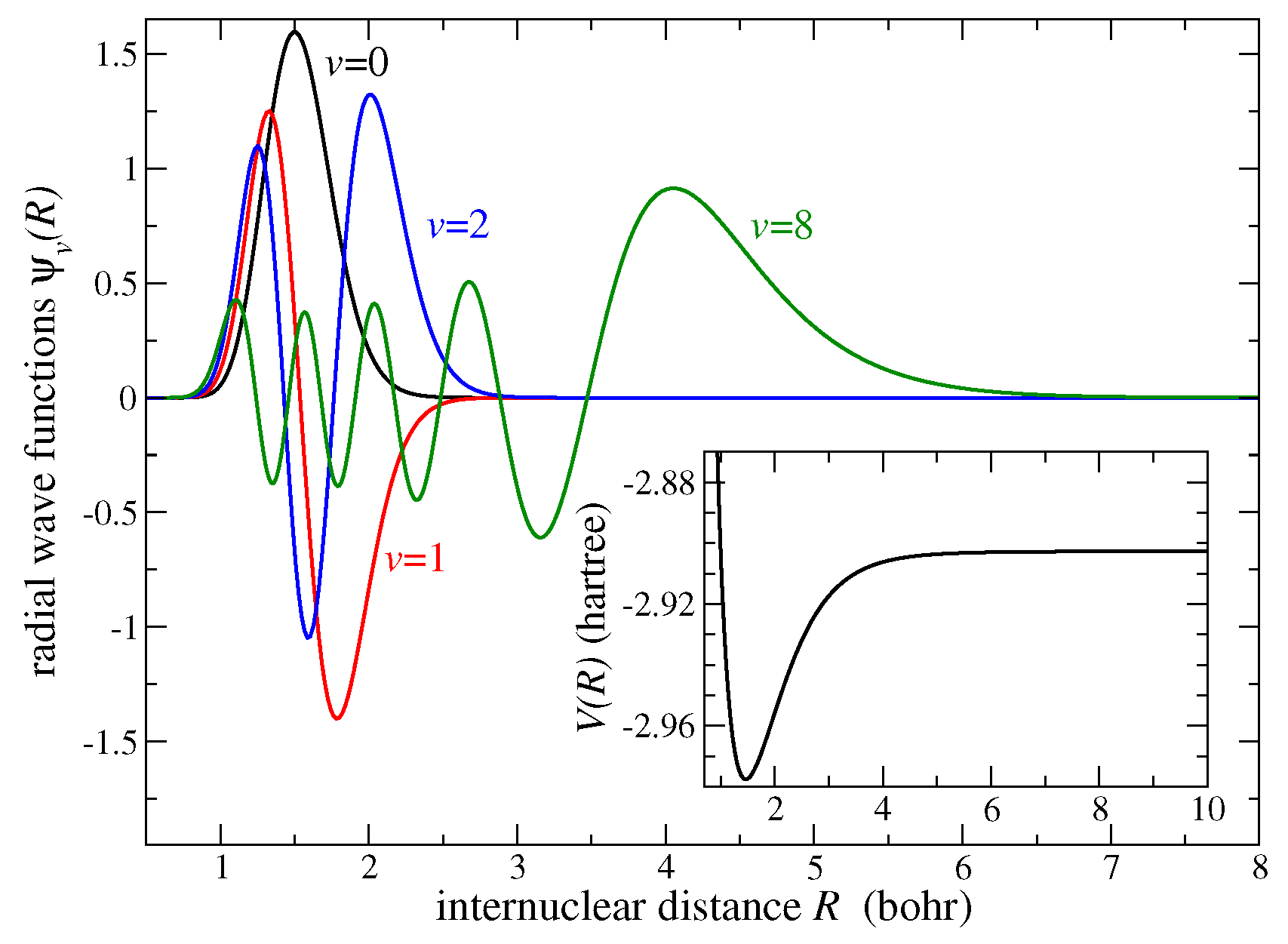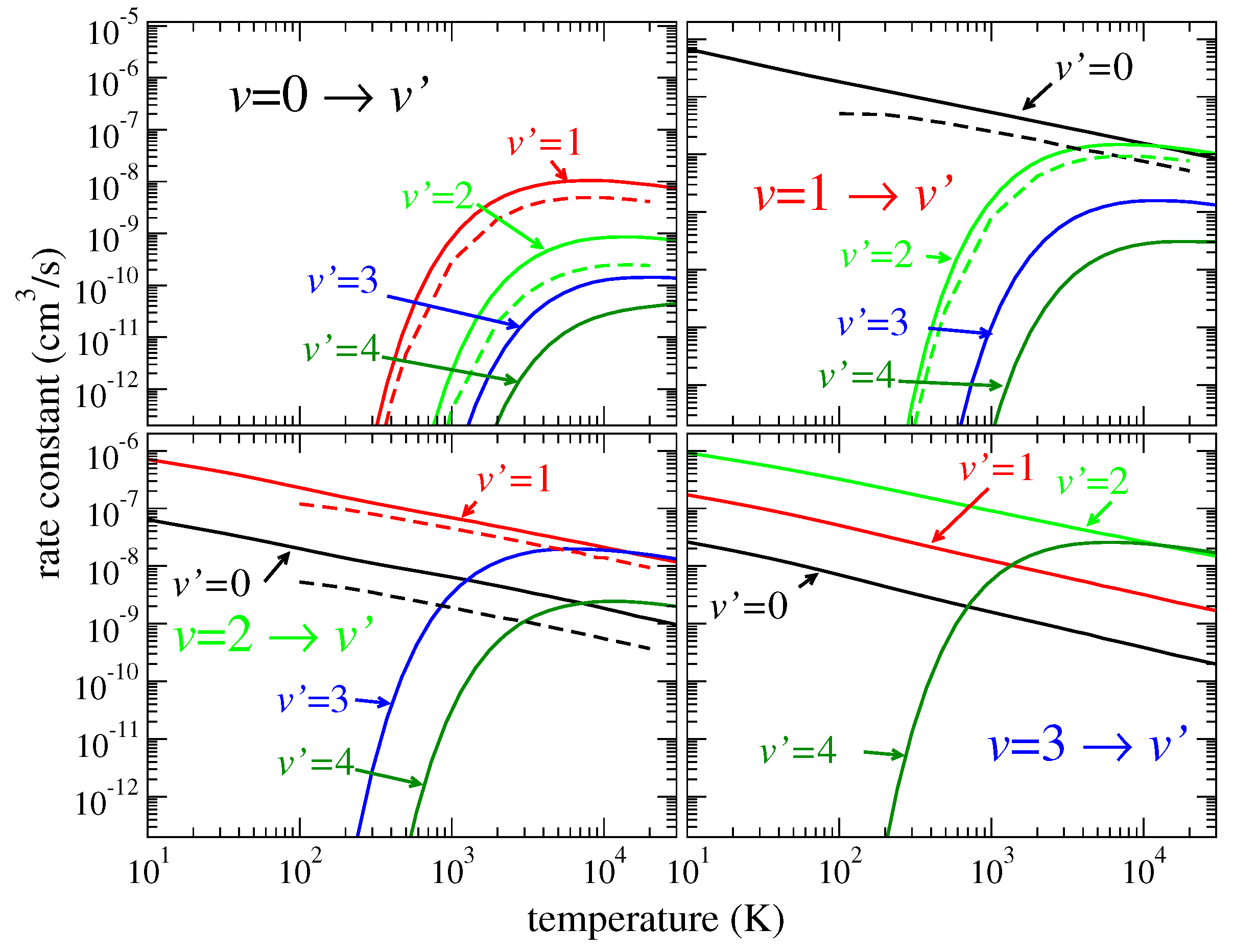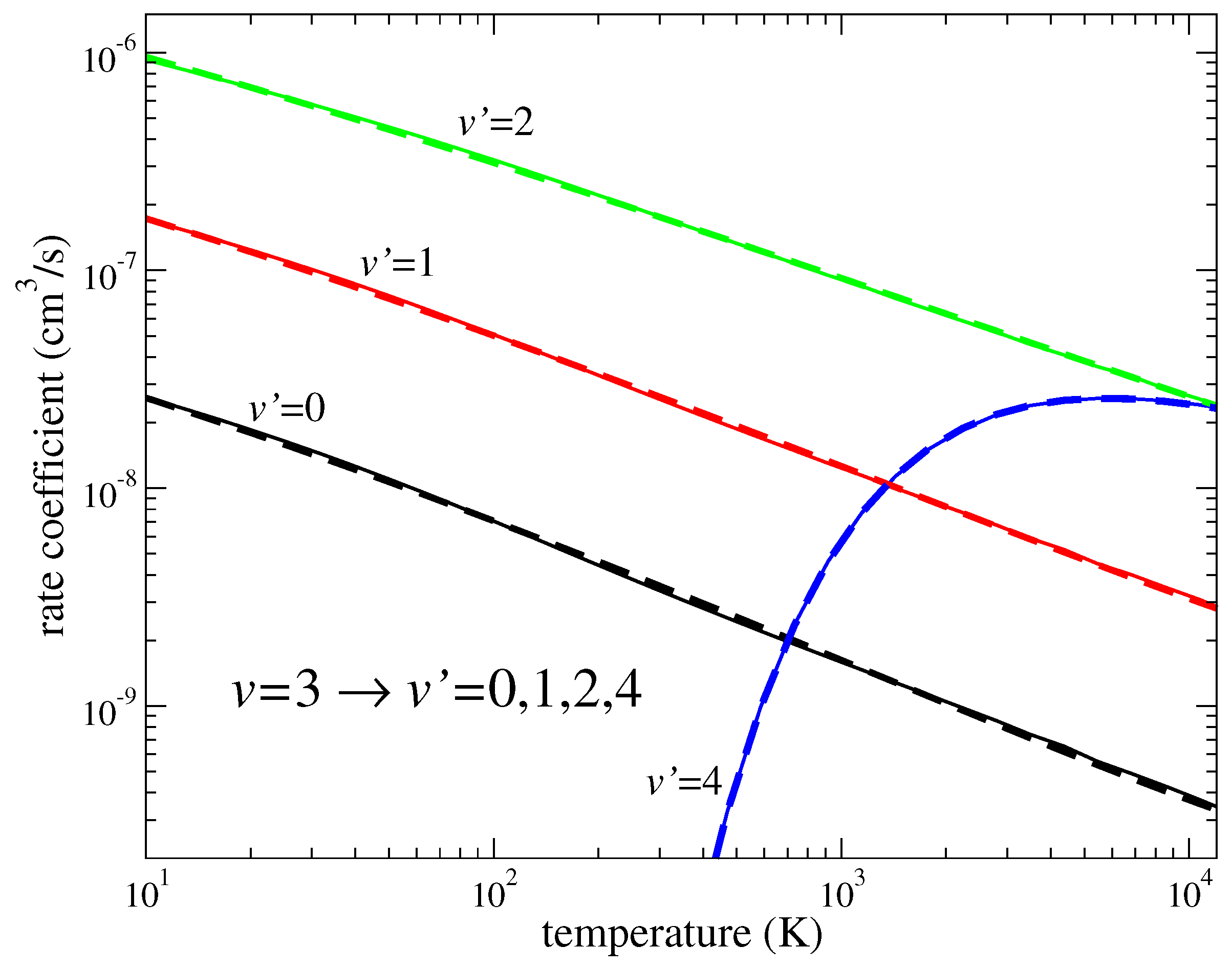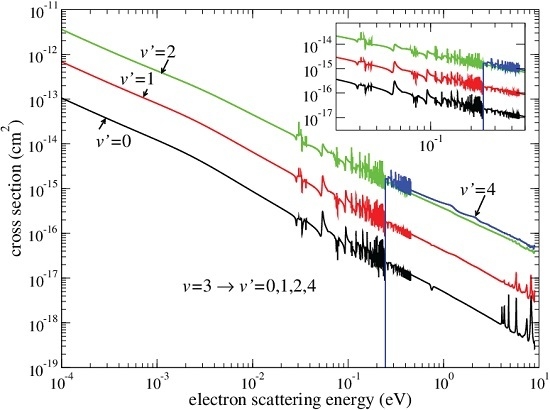Cross Sections and Rate Coefficients for Vibrational Excitation of HeH+ Molecule by Electron Impact
Abstract
:1. Introduction
2. Theoretical Approach
2.1. Scattering Matrix for Fixed Geometries Of HeH
2.2. HeH Vibrational Dynamics
2.3. The Scattering Matrix for an Electron Colliding with HeH
2.4. Elimination of Channels Closed for Ionization From the Scattering Matrix
3. Rate Coefficients and Cross Sections for Vibrational (De-)Excitation
4. Conclusions and Discussion
Acknowledgments
Author Contributions
Conflicts of Interest
References
- Roberge, W.; Dalgarno, A. The formation and destruction of HeH+ in astrophysical plasmas. Astrophys. J. 1982, 255, 489–496. [Google Scholar] [CrossRef]
- Dabrowski, I.; Herzberg, G. The predicted infrared spectrum of HeH+ and its possible astrophysical importance. Trans. N. Y. Acad. Sci. 1977, 38, 14–25. [Google Scholar] [CrossRef]
- Black, J. Molecules in planetary nebulae. Astrophys. J. 1978, 222, 125–131. [Google Scholar] [CrossRef]
- Flower, D.; Roueff, E. On the formation and destruction of HeH+ in gaseous nebulae and the associated infra-red emission line spectrum. Astron. Astrophys. 1979, 72, 361–366. [Google Scholar]
- Lepp, S.; Stancil, P.; Dalgarno, A. Atomic and molecular processes in the early Universe. J. Phys. B At. Mol. Opt. Phys. 2002, 35, R57. [Google Scholar] [CrossRef]
- Zygelman, B.; Dalgarno, A. The radiative association of He+ and H. Astrophys. J. 1990, 365, 239–240. [Google Scholar] [CrossRef]
- Kraemer, W.; Špirko, V.; Juřek, M. Formation of HeH+ by radiative association of He+ + H. An advanced ab initio study. Chem. Phys. Lett. 1995, 236, 177–183. [Google Scholar] [CrossRef]
- Strömholm, C.; Semaniak, J.; Rosén, S.; Danared, H.; Datz, S.; van der Zande, W.; Larsson, M. Dissociative recombination and dissociative excitation of 4HeH+: Absolute cross sections and mechanisms. Phys. Rev. A 1996, 54, 3086–3094. [Google Scholar] [CrossRef] [PubMed]
- Tanabe, T.; Katayama, I.; Ono, S.; Chida, K.; Watanabe, T.; Arakaki, Y.; Haruyama, Y.; Saito, M.; Odagiri, T.; Hosono, K.; et al. Dissociative recombination of isotopes with an ultra-cold electron beam from a superconducting electron cooler in a storage ring. J. Phys. B At. Mol. Opt. Phys. 1998, 31, L297. [Google Scholar] [CrossRef]
- Larson, Å.; Orel, A. Wave-packet study of the products formed in dissociative recombination of HeH+. Phys. Rev. A 2005, 72, 032701. [Google Scholar] [CrossRef]
- Takagi, H. Theoretical study of the dissociative recombination of HeH+. Phys. Rev. A 2004, 70, 022709. [Google Scholar] [CrossRef]
- Larson, Å.; Nkambule, S.; Ertan, E.; Söder, J.; Orel, A.E. Studies of HeH: DR, RIP, VE, DE, PI, MN, ... EPJ Web Conf. 2015, 84, 03001. [Google Scholar] [CrossRef]
- Takagi, H.; Tashiro, M. Study on the dissociative recombination of HeH+ by multi-channel quantum defect theory. EPJ Web Conf. 2015, 84, 02002. [Google Scholar] [CrossRef]
- Jimenez-Serra, I.; Martin-Pintado, J.; Viti, S.; Martin, S.; Rodriguez-Franco, A.; Faure, A.; Tennyson, J. The first measurements of the electron density enhancements expected in C-type shocks. Astrophys. J. Lett. 2006, 650, L135–L138. [Google Scholar] [CrossRef]
- Rabadán, I.; Sarpal, B.K.; Tennyson, J. Calculated rotational and vibrational excitation rates for electron-HeH+ collisions. Mon. Not. R. Astron. Soc. 1998, 299, 171–175. [Google Scholar] [CrossRef]
- Tennyson, J. Electron–molecule collision calculations using the R-matrix method. Phys. Rep. 2010, 491, 29–76. [Google Scholar] [CrossRef]
- Carr, J.; Galiatsatos, P.; Gorfinkiel, J.; Harvey, A.; Lysaght, M.; Madden, D.; Mašín, Z.; Plummer, M.; Tennyson, J.; Varambhia, H. UKRmol: A low-energy electron-and positron-molecule scattering suite. Euro. Phys. J. D 2012, 66, 58. [Google Scholar] [CrossRef]
- Seaton, M.J. Quantum defect theory. Rep. Prog. Phys. 1983, 46, 167. [Google Scholar] [CrossRef]
- Greene, C.H.; Jungen, C. Molecular Applications of Quantum Defect Theory. Adv. At. Mol. Phys. 1985, 21, 51. [Google Scholar]
- Aymar, M.; Greene, C.H.; Luc-Koenig, E. Multichannel Rydberg spectroscopy of complex atoms. Rev. Mod. Phys. 1996, 68, 1015. [Google Scholar] [CrossRef]
- Tennyson, J.; Brown, D.B.; Munro, J.J.; Rozum, I.; Varambhia, H.N.; Vinci, N. Quantemol-N: An expert system for performing electron molecule collision calculations using the R-matrix method. J. Phys. Conf. Ser. 2007, 86, 012001. [Google Scholar] [CrossRef]
- Faure, A.; Gorfinkiel, J.D.; Morgan, L.A.; Tennyson, J. GTOBAS: Fitting continuum functions with Gaussian-type orbitals. Comput. Phys. Commun. 2002, 144, 224. [Google Scholar] [CrossRef]
- Kokoouline, V.; Dulieu, O.; Kosloff, R.; Masnou-Seeuws, F. Mapped Fourier methods for long-range molecules: Application to perturbations in the Rb2 () photoassociation spectrum. J. Chem. Phys. 1999, 110, 9865–9876. [Google Scholar] [CrossRef]
- Werner, H.J.; Knowles, P.J.; Lindh, R.; Manby, F.R.; Schütz, M.; Celani, P.; Korona, T.; Lindh, R.; Mitrushenkov, A.; Rauhut, G.; et al. MOLPRO. Version 2008.3, a Package of Ab Initio Programs. 2008. [Google Scholar]
- Coxon, J.A.; Hajigeorgiou, P.G. Experimental Born-Oppenheimer Potential for the X1Σ+ Ground State of HeH+: Comparison with the Ab Initio Potential. J. Mol. Spectrosc. 1999, 193, 306–318. [Google Scholar] [CrossRef] [PubMed]
- Stanke, M.; Kędziera, D.; Molski, M.; Bubin, S.; Barysz, M.; Adamowicz, L. Convergence of Experiment and Theory on the Pure Vibrational Spectrum of HeH+. Phys. Rev. Lett. 2006, 96, 233002. [Google Scholar] [CrossRef] [PubMed]
- Jungen, C.; Atabek, O. Rovibronic interactions in the photoabsorption spectrum of molecular hydrogen and deuterium: An application of multichannel quantum defect methods. J. Chem. Phys. 1977, 66, 5584–5609. [Google Scholar] [CrossRef]
- Kokoouline, V.; Greene, C.H. Theory of dissociative recombination of D3h triatomic ions applied to . Phys. Rev. Lett. 2003, 90, 133201. [Google Scholar] [CrossRef] [PubMed]






| Level v | [26] | [25] | ||
|---|---|---|---|---|
| 0 | 2913 | 2911.0007 | 33.527 | 33.558 |
| 1 | 2607 | 2604.1676 | 30.816 | 30.839 |
| 2 | 2300 | 2295.5787 | 28.088 | 28.090 |
| 3 | 1988 | 1982.0562 | 25.305 | 25.301 |
| 4 | 1668 | 1660.3559 | 22.425 | 22.402 |
| 5 | 1339 | 1327.7860 | 19.394 | 19.344 |
| 6 | 1000 | 984.3599 | 16.151 | 16.058 |
| 7 | 660 | 639.1959 | 12.645 | 12.479 |
| 8 | 328 | 327.3615 | 8.813 | 8.621 |
| 0–1 | 0–2 | 0–3 | 0–4 | 1–2 | 1–3 | 1–4 | 2–3 | 2–4 | 3–4 | |
|---|---|---|---|---|---|---|---|---|---|---|
| 4191 | 7942 | 11251 | 14112 | 3751 | 7060 | 9920 | 3309 | 6169 | 2860 | |
| (K) | ||||||||||
| 0.23e-5 | 0.20e-6 | 0.75e-7 | 0.11e-7 | 0.21e-5 | 0.47e-6 | 0.80e-7 | 0.24e-5 | 0.44e-6 | 0.28e-5 | |
| −0.11e-6 | −0.20e-8 | 0.88e-8 | 0.31e-9 | 0.95e-7 | 0.62e-7 | −0.71e-9 | 0.34e-6 | −0.53e-8 | 0.16e-8 | |
| 0.25e-8 | 0.10e-8 | −0.28e-8 | −0.24e-10 | −0.18e-7 | −0.16e-7 | 0.76e-9 | −0.56e-7 | 0.40e-8 | 0.13e-7 | |
| 0.85e-10 | −0.11e-9 | 0.15e-9 | −0.56e-12 | 0.79e-9 | 0.85e-9 | −0.76e-10 | 0.22e-8 | −0.36e-9 | −0.92e-9 |
© 2016 by the authors; licensee MDPI, Basel, Switzerland. This article is an open access article distributed under the terms and conditions of the Creative Commons Attribution (CC-BY) license (http://creativecommons.org/licenses/by/4.0/).
Share and Cite
Ayouz, M.; Kokoouline, V. Cross Sections and Rate Coefficients for Vibrational Excitation of HeH+ Molecule by Electron Impact. Atoms 2016, 4, 30. https://doi.org/10.3390/atoms4040030
Ayouz M, Kokoouline V. Cross Sections and Rate Coefficients for Vibrational Excitation of HeH+ Molecule by Electron Impact. Atoms. 2016; 4(4):30. https://doi.org/10.3390/atoms4040030
Chicago/Turabian StyleAyouz, Mehdi, and Viatcheslav Kokoouline. 2016. "Cross Sections and Rate Coefficients for Vibrational Excitation of HeH+ Molecule by Electron Impact" Atoms 4, no. 4: 30. https://doi.org/10.3390/atoms4040030







